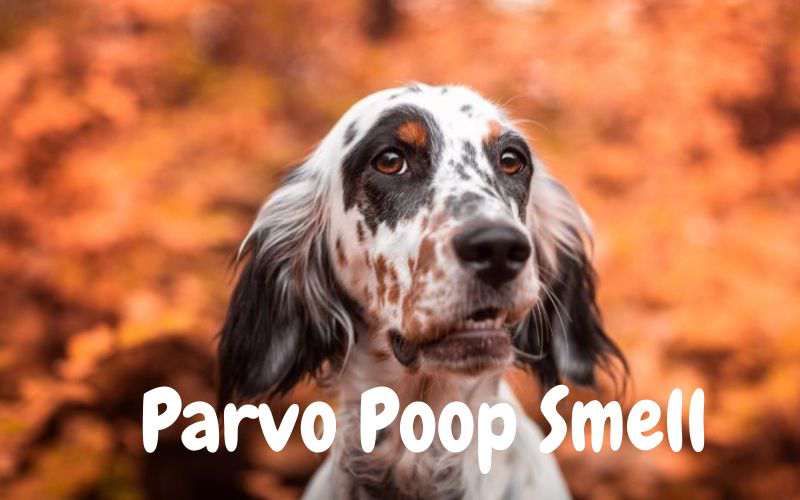There is a characteristic metallic smell of parvovirus-infected dog feces/feces. The wastes contain intestinal lining and spilled blood, which creates an awful smell. Additionally, it may have a slightly sweet or putrid smell. The scent of parvo poo is unique. In this article, we will let you know the parvo poop smell.
Table of Contents
Why is there a Parvo smell?
When the virus enters the bloodstream, it weakens the immune system by destroying bone marrow cells and allowing it to enter the gastrointestinal tract. The virus targets the epithelium of the small intestine, allowing the organ to absorb nutrients and creating a barrier against entry into the body. This invasion does not allow the intestines to absorb nutrients properly.
The early stages of Parvo can be bloodless and odorless. But as it progresses, the stool may be dark red or light red. Dark red is digested blood from further up the gut. The bright red blood is undigested and comes from the lower intestine. This blood is a significant contributor to the metallic odor of Pavi’s feces.
The most common symptoms of Parvo are lethargy, depression, and loss of appetite. A rapid onset of high fever, vomiting, and diarrhea follows this.
What is Parvo?
Canine parvovirus “parvo” is a contagious virus in dogs that causes acute gastrointestinal illness. Parvo first appeared in dogs in Europe in 1976. Within two years, it spread uncontrollably through the population, causing intestinal and heart problems. The current theory is that the virus arose from mutations in the feline panleukopenia virus (FPV). Additionally, the disease can cause infections in feral dogs or other wild animals.
Since the development of vaccines, the prevalence of Parvo has decreased significantly. Puppies should receive a complete cycle of Parvo vaccinations at eight, twelve, and sixteen weeks. Adult dogs should be given a parvovirus booster every one to three years.
It is difficult to determine where your dog could contract parvovirus. Puppies that are not fully vaccinated are more susceptible to contracting the disease. However, immunocompromised dogs or exposed to high levels can develop the disease. Not all exposed dogs will develop the disease.
What does Parvo poop look like?
That distinctive metallic smell characterizes Parvus poop. But it has other characteristics that you can use to identify it.
The color of Parvos’s feces can be brown, black, or almost red. It often contains streaks of older, darker blood from the upper part of the intestine. The bright red blood comes from the lower intestine. Also, parvos’ stools sometimes contain mucus, making them thick and sticky.
How long does the smell last?
The infected dog sheds parvo particles in its feces before and after showing clinical signs. You can excrete virus particles for up to 6 weeks after recovery, which is how long stools smell.
Although the odor may be more intense with higher particles in the feces, it is not an indicator of the severity of your pet’s illness. Each puppy with Parvo has a unique interaction with the disease.
Can dogs contract Parvo by smelling other dogs’ feces with the disease?
Infectious factors outweigh exposure in importance. Parvo, though, can survive outside for up to a year. Your dog may be sick if he smells like parvovirus.
I smell something metallic in my dog’s poop. Do I have to do this?
If you smell something metallic in your dog’s poop, it’s probably Parvo. Parvo most commonly affects puppies between the ages of six and twenty weeks but can also infect older animals. Dogs not receiving all vaccinations or booster shots are more likely to contract Parvo.
Puppies under five months old often show the most severe symptoms and are the most difficult to treat. If you suspect Parvo, make an appointment with your vet right away.
How will my vet treat Parvo?
To diagnose your dog, the vet will perform an inexpensive fecal test by taking a rectal swab. That is to determine if the area has been sick with cells. Additionally, vets may recommend a blood test to check for white blood cell counts or other issues. Dogs with Parvo may be anemic due to blood loss or low blood sugar due to diarrhea or vomiting. There can be several causes for vomiting or diarrhea, so your vet may recommend x-rays or ultrasounds.
The Parvo treatment is more of a treatment than a cure. The vet will administer intravenous fluids and electrolytes to keep your dog hydrated. Some veterinarians give antibiotics to prevent secondary infections. Other medications may be to relieve vomiting, nausea, and pain. Dewormers are certain because puppies often have intestinal parasites that can worsen diarrhea.
Since the dog is not feeling well enough to feed, the vet will provide a temporary feeding tube for nutritional support. In severe cases, a plasma transfusion may be desirable to replace the clotting factors and blood proteins that the virus has attacked.
Will my dog survive Parvo?
Survival can vary, but the most crucial factor is treatment time. The survival rate of veterinary-treated dogs is 68-92%. A good indicator of a full recovery is if the dog survives the first three to four days.
What can I do to treat Parvo at home?
Ideally, a dog with Parvo should be hospitalized to ensure the best care and attention. However, outpatient treatment has proven its worth in the case of financial problems. It’s essential to ensure the owner is on medication on a strict schedule and to have daily check-ups with the vet to ensure the dog is doing well. The survival rate with home care is 50%.
Some would recommend giving Parvaid to Parvo-infected dogs. It has a 91% survival rate in unvaccinated dogs. Harvard is an organic nutraceutical rich in vitamin C. However, no rigorous research studies led to support these claims.
Once your dog is infected, could you give him a thorough clean? The virus can survive for up to a month indoors and almost a year outdoors under the right conditions.
How do you get rid of the parvo smell?
The best way to kill parvoviruses is to use a bleach solution. However, disinfection is more difficult on surfaces that cannot be shabby, such as grass or carpets. If there is good drainage outdoors, watering the area can dilute the virus.
Parvo’s scent is gone. Is my dog cured?
It could be a positive sign of recovery. However, it’s best to gauge recovery based on your dog’s vomiting, eating habits, and activity level. Less or no blood in the stool can signal that your dog is doing better.
Also read: Banana Backwoods
Also read: HEP In Physical Therapy







